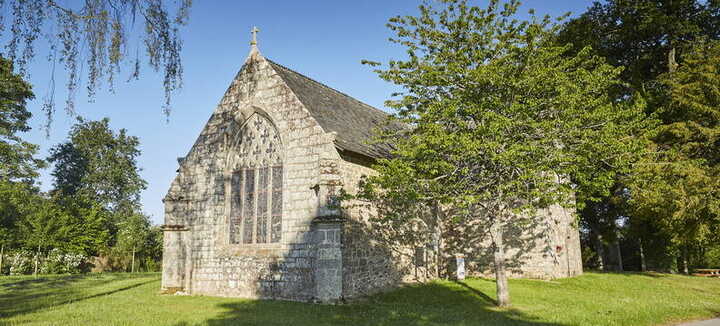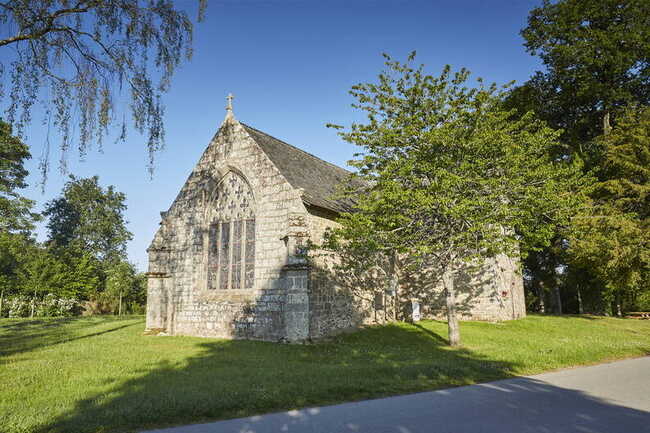
Landévant - Lannouan circuit
Église Saint-Martin
56690 Landévant
56690 Landévant
Features of the route
Difficulty
Easy
Length
1h00
Distance
4km
Église Saint-Martin
56690 Landévant
56690 Landévant
Difficulty level: Easy Yellow markings All year round A short hike to discover the Church of Saint-Martin, the Château de Lannouan, the surrounding woods and Landévant's heritage.
Departure: From the Church of Saint-Martin, completely rebuilt in 1834. It replaces a 15th-century building of which a few animal sculptures remain. Inscriptions in Gothic script bear the dates 1413 and 1422. The tower was built in 1857. Take rue de l'Église, cross rue Nationale to rue du Bois/rue du Pont Neuf (towards Baud).
1) After the 1st street, turn right into the green lane for 300 m. Cross the street and turn right into the tree-lined driveway (private property).
2) Turn right, then immediately left, into the large, shady driveway. Drive along the wall bordering the gardens of Château de Lannouan.
3) In front of a wrought-iron gate, see the superb 18th-century château. Privately owned, it is not open to the public. The de Perrien family built Château de Lannouan after purchasing the former manor house and its outbuildings in 1702. Continue along the path to Talvern (very old buildings). At the entrance to the village of Talvern is a wash-house, once common to the area but now private following the land consolidation.
4) Turn right into the village.
5) After 400 m, turn left towards the hamlet of Kerverh.
6) After 100 m on the road, turn right along the fields and then into a small wood (private property).
7) Cross the Talvern stream. Follow the signs through a housing estate.
8) Turn left and follow the sunken path. Before crossing Rue d'Auray, look out on the right for a superb window lintel (9 Rue d'Auray) featuring two figures: Landévant and his wife, surrounded by masons' tools. This lintel was reused when the house was built.
9) Cross the rue d'Auray into the rue de la Grange, opposite. At no. 2 rue de la Grange, you'll see a typical Breton well (2 rue de la Grange, private property). It is topped by five balls marking the number of families entitled to use it. Walk past the presbytery, where an Iron Age stele stands in the garden. This funerary stele dates from the La Tène period (between 450 and 25 BC). Formerly located in the cemetery (Rosenzweig), it may have been Christianized during the first Christianization of the area. The stele was probably moved at the end of the 19th century when the cemetery was moved (1891) to the garden of the present-day presbytery.
Departure: From the Church of Saint-Martin, completely rebuilt in 1834. It replaces a 15th-century building of which a few animal sculptures remain. Inscriptions in Gothic script bear the dates 1413 and 1422. The tower was built in 1857. Take rue de l'Église, cross rue Nationale to rue du Bois/rue du Pont Neuf (towards Baud).
1) After the 1st street, turn right into the green lane for 300 m. Cross the street and turn right into the tree-lined driveway (private property).
2) Turn right, then immediately left, into the large, shady driveway. Drive along the wall bordering the gardens of Château de Lannouan.
3) In front of a wrought-iron gate, see the superb 18th-century château. Privately owned, it is not open to the public. The de Perrien family built Château de Lannouan after purchasing the former manor house and its outbuildings in 1702. Continue along the path to Talvern (very old buildings). At the entrance to the village of Talvern is a wash-house, once common to the area but now private following the land consolidation.
4) Turn right into the village.
5) After 400 m, turn left towards the hamlet of Kerverh.
6) After 100 m on the road, turn right along the fields and then into a small wood (private property).
7) Cross the Talvern stream. Follow the signs through a housing estate.
8) Turn left and follow the sunken path. Before crossing Rue d'Auray, look out on the right for a superb window lintel (9 Rue d'Auray) featuring two figures: Landévant and his wife, surrounded by masons' tools. This lintel was reused when the house was built.
9) Cross the rue d'Auray into the rue de la Grange, opposite. At no. 2 rue de la Grange, you'll see a typical Breton well (2 rue de la Grange, private property). It is topped by five balls marking the number of families entitled to use it. Walk past the presbytery, where an Iron Age stele stands in the garden. This funerary stele dates from the La Tène period (between 450 and 25 BC). Formerly located in the cemetery (Rosenzweig), it may have been Christianized during the first Christianization of the area. The stele was probably moved at the end of the 19th century when the cemetery was moved (1891) to the garden of the present-day presbytery.


